With so much attention on the mayoral race and national politics, you might not have heard much about an interesting contest shaping up for a seat in the Oregon House that represents a key swath of east Portland.
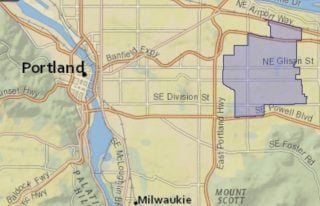
When I heard the name Ashton Simpson pop up as a third-party challenger to scandal-plagued incumbent Diego Hernandez, I knew you’d be interested to learn about him. Simpson, who’s running on the Working Families Party ticket, has deep ties to local transportation issues.
As you might have noticed with our recent coverage of new neighborhood greenways, east Portland is seeing a lot of transportation investment at the moment. That stream of funding will become a flood if the Metro transportation measure passes in November. After years of neglect, parts of our city east of I-205 are finally being noticed by City Hall. And it’s active, young leaders like Simpson who are making that happen.
I asked him a few questions via email last week and I’ve shared his responses below. (Edited slightly for clarity.)
How do you get around the city in a normal week?
I live in east Portland where the street design and lack of safe infrastructure limits the choices I have available to me, therefore my primary mode is a car. However, prior to COVID-19 I would use transit whenever heading downtown. I do have a bike and would love to use it more which is one of the reasons I love the work I do advocating for equitable mobility options and investments in East Portland.
What neighborhood do you live in?
I live in the Russell neighborhood. It is one of the few in East Portland that has decent sidewalks until you get to the main streets. I believe in a future where all of East Portland has the same level of investments as the rest of the city.
What transportation projects/issues are you currently involved in?
I’ve had the privilege to be heavily involved in transportation justice work in Portland. My work at The Rosewood Initiative has allowed me to be directly involved in local transportation advocacy over the past few years. I am on the City of Portland’s Pricing Options for Equitable Mobility Task Force, the Rose Lane Project Committee, and am the co-chair of the Fixing Our Streets Oversight body. I was also on the Multnomah County Local Investment Team for the Metro Transportation measure where I advocated for safer streets for all users. I have also worked with PBOT on specific projects, such as reorganizing SE 162nd Ave.
Advertisement
How do you feel about the I-5 Rose Quarter project?
“The hundreds of millions of dollars dedicated to the I-5 project could instead be used to improve underserved parts of the city.”
I believe the I-5 project is a waste of money that will not achieve any of the stated goals. In East Portland, we have major streets like Holgate that still do not have sidewalks. A lot of the neighborhood collectors still look like rural two lane roads, leaving people walking and biking with virtually no space to exist. Justice too long delayed is justice denied. East Portland has been denied adequate investments in biking, walking, and transit despite being annexed half a century ago.
The hundreds of millions of dollars dedicated to the I-5 project could instead be used to improve underserved parts of the city like 82nd Ave., Cully, and East Portland. These funds could increase walking, biking, and transit infrastructure that creates safer communities and addresses climate change. If elected, I will give my colleagues in the legislature ample opportunity to show their commitment to racial justice and redirect resources to Communities of Color where people are actually dying in our transportation system.
Critics of the Metro funding measure say it doesn’t do enough to combat climate change, spends too much on a MAX line, and doesn’t do enough to curb car use. Why do you support it?
I understand the sentiment and recognize that no measure is perfect. Sometimes, the journey is more important than the destination. We need to start with the recognition that there were many divergent interests and parties at the table. Due to Metro’s concerted effort to share power and listen to voices advocating for transportation justice, we were able to push this measure further than we ever had. The measure goes a long way in creating access for walking, biking, and transit along some of the most dangerous corridors in the region, including four in East Portland; 82nd, 122nd, 162nd, and 181st. The program side of the measure includes anti-displacement funding, youth pass for transit, and Safe Routes to School. These were all things we fought hard for and Metro listened. And finally, this measure is only one part of a larger puzzle in addressing climate change. To address climate change we must continue to invest and expand our infrastructure which is why as state legislator, I will ensure the state takes the lead on addressing climate change by funding a Green New Deal and working to reduce vehicle use.
What has been your experience navigating Portland streets as a Black man?
“The individual racism expressed towards me is difficult to convey to someone who isn’t Black and encompasses everything from rudeness to overt acts of hostility.”
Driving, walking, biking, and transit while Black is real. My experiences are part of a greater systemic pattern of discrimination. The individual racism expressed towards me is difficult to convey to someone who isn’t Black and encompasses everything from rudeness to overt acts of hostility.
Moreover, there is institutional racism in the way in which East County was designed, where highways were built in Black neighborhoods, which causes negative health outcomes for Black families due to the noise and pollution that goes with them. Then, there is the lack of sidewalks for community members to get to places without being afraid someone will run you off the road. There is also the lack of comprehensive transit that doesn’t do enough to address increasing distances between home and economic opportunity. Finally, there is the lack of safe bike facilities where my son and I can safely ride our bikes and much more.
Advertisement
How does the transportation issue intersect with racial, economic, and environmental justice?
We cannot speak about racism, economic justice, transportation justice, and environmental justice without each other because they all influence each other. Black and Brown people are isolated in communities with limited transportation options due to intentional and racist urban planning. These communities overwhelmingly rely on transit to get to work, but the jobs are too far away to use transit so they are not attainable. The transit is also not as good as in white and affluent communities. Without access to living wage jobs people are stuck in unskilled, low paying jobs. They aren’t able to build generational wealth that comes with homeownership. Too many people in my district have to buy a car to reach jobs that are on the other side of town, causing long commutes, more pollution, and more time spent in traffic. This causes economic stratification of Black and Brown families reinforcing disaster capitalism and environmental catastrophe.
If you had $5 million to spend on transportation in East Portland, what would you do with it?
$5 million doesn’t buy much, maybe one mile of sidewalk, or three or four marked crosswalks. That is why we need to look at more and better ways of funding transportation. We have to change the way we fund transportation and we have to eliminate the mental and physical restrictions that are currently imposed on us in order to acquire the revenue we need.
The future we are entitled to in East Portland, a future without disparities in crashes, funding, access, and power, require us to summarily reject the notion that $5 million comes anywhere close to financing the future our communities deserve.
Anything else you’d like to share?
Traffic crashes are not accidents. They are predictable results of systemic failures.
It is no accident that the part of the region that is overrepresented in traffic violence (East Portland) is also the part of the region that has historically lacked political power. It is the same part of the region that also has food deserts, gun violence, disparities in COVID deaths, and lower life expectancies. Violence, in all forms, falls along lines of race and class. These harms are often suffered alone, silently, in under-invested neighborhoods, out of view of those in power. We will not get to Vision Zero unless and until we address the disparities in power, access, funding, and systemic racism that exists in East Portland and within city/state government.
Between COVID, racism, and the wildfires, the current crises have taught us how interconnected our lives are. If your readers are interested in an equitable East Portland, I’d welcome them to check out our website and consider making a donation to our people-powered campaign at AshtonforEastPortland.com. People can also connect with us via Twitter at @Ashton4eastpdx and email at AshtonforEastPortland@gmail.com.
Thanks Ashton. Good luck in your race. I have a feeling you’ll be on these pages (win or lose) a lot more in the future.
— Jonathan Maus: (503) 706-8804, @jonathan_maus on Twitter and jonathan@bikeportland.org
— Get our headlines delivered to your inbox.
— Support this independent community media outlet with a one-time contribution or monthly subscription.


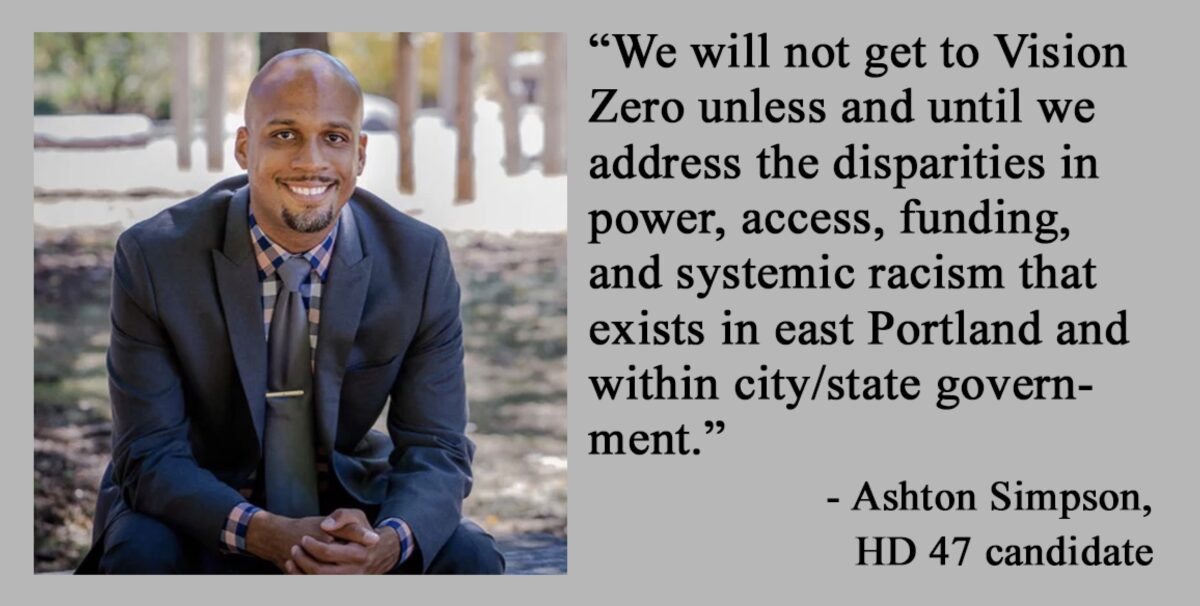
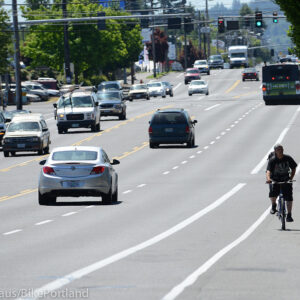
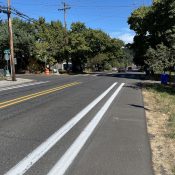
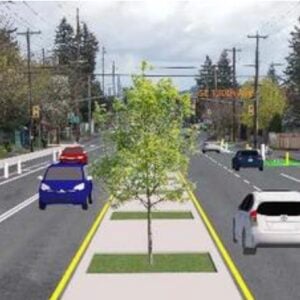
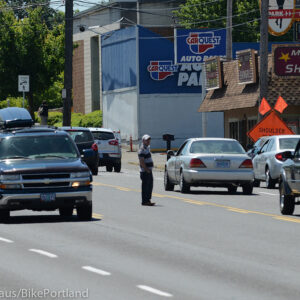
Thanks for reading.
BikePortland has served this community with independent community journalism since 2005. We rely on subscriptions from readers like you to survive. Your financial support is vital in keeping this valuable resource alive and well.
Please subscribe today to strengthen and expand our work.
Ashton is the real deal –smart, compassionate… He can win this race.
As an East Portlander and an activist for transportation and housing justice, I am 100% for Ashton Simpson for HD47.
Ashton has my vote. Let’s fight for Vision Zero. And lets build the Bicycle Master Plan. I’m also voting for Sarah Ianaronne/ against Ted Wheeler.
BP has mouthed “Vision Zero” for as long as I can remember, and according to statistics it has accomplished little if anything. Am I right? What is that old saying about doing the same thing over and over and expecting different results? Here’s a 5 minute video on expecting the government to accomplish anything for you – works the same for all levels of government:
https://www.youtube.com/watch?v=qypnQkdg89g
You know what the problem with Vision Zero is? It calls, in large part, for lowering speed limits. However, motorists do not comply.
This is not an error on the part of Vision Zero, unless you propose some automated penalty to be invoked. Such as speed cameras, or shock collars.
As far as your video goes, it’s not in context to the comment that you made. Ironic that you would choose a prominent black professor to enhance your claim.
Go Ashton go! I donated a couple bucks. Would be fantastic to have Ashton’s voice in the Oregon Legislature.
This really gets to the reason why cycling is predominantly a white male sport. Simply because of the vulnerability that cycling entails. Also, the reason why there are so many angry cyclists. That vulnerability is taken advantage of constantly. White men can get angry, but marginalized populations have more at risk.
There’s a quote to describe driving a VW Bus, from How to Keep Your Volkswagen Alive: A Manual of Step-by-Step Procedures for the Complete Idiot. It goes something like, “if everyone drove like they were Aztec sacrifices tied to the front of their vehicle, the roads would be much safer”. As it is now, a lot of people drive like the executioner.
Lot’s of people get angry and some of them shoot you over it. How’s Mike Hildebrandt doing?
TL;DR: watch out for the loose nut behind the wheel.
I have cameras fore and aft. I don’t touch cars. I avoid engagement as much to put a good face on for cycling as to protect myself. I treat every motorist like an armed lunatic, because they are. Even if they don’t have a gun, they have a steering wheel. That is my credo and that is how I conduct myself.
One irony is that where he lives, there is a large portion of Russell and nearby Wilkes neighborhoods that were part of a development called “Ascot Acres” that had large 8,400 square foot parcels, with covenant code restrictions that specifically excluded Blacks and Jews from owning homes there, long ago ruled illegal. But the large SFR lots are still enforced in the city planning code.
The city-funded/sponsored displacement of black people to peripheral neighborhoods was definitely racist.

The maps are based on the census, which doesn’t distinguish between the African-Americans of north central Portland who were displaced by gentrification on the one hand, and the other hand the new immigrants and refugees from Africa who moved or were re-settled into East Portland starting in the 90s. There was of course some movement of African-Americans from North Central to East Portland, but not as much as implied in these maps – most left the city altogether. I agree with you that both the gentrification and re-settlement was racist, but also economic, as was the city-sponsored negligence patterns and history in both areas of town, as well as by other public agencies.
https://www.pdxmonthly.com/news-and-city-life/2012/02/african-american-churches-north-portland-march-2012
Also see the source of the image I posted above here:
https://pdxscholar.library.pdx.edu/cgi/viewcontent.cgi?article=1022&context=honorstheses
“most left the city altogether”
Do you have any evidence for this?
(I should also note that census PUMS data can be used to monitor displacement within a city.)
https://www.colorlines.com/articles/gentrification-spotlight-how-portland-pushing-out-its-black-residents-part-2
https://www.pdxmonthly.com/news-and-city-life/2012/02/african-american-churches-north-portland-march-2012
“most left the city altogether” Do you have any evidence for this?
Yes, but I don’t have access to the data. When I lived in East Portland, I often spoke with administrators for the David Douglas and Parkrose School Districts. They would point out that most of their young black students’ parents did not come from inner Portland, but rather from other parts of the USA or from overseas (Somali, Ethiopian, west African, etc.) On a personal level, I’ve actually met several black individuals here in North Carolina who would tell me, once I mentioned I lived in Portland Oregon for a while, that they too were from Portland but could no longer afford it, usually from Kenton or Elliot, and left a few years ago. They are almost all universally happier now where they are living than when they lived in Portland, which they found oppressively racist.
I did see an academic diaspora study from a few years ago about blacks from north central Portland (as well as parts of DC) and where they ended up, but I now have no idea where I saw it.
Looking at these maps, I can also spin this as blacks were concentrated in a inner-city ghetto with poor schools, access to employment opportunities, pollution and crime and have since been more widely integrated into the rest of the city. It is undeniable the whole map became greyer with less highlights. How is this not progress?
It looks like the result of a successful integration project.
“inner-city ghetto”
Could you please try to be a little less overtly racist?
Why is it so hard for privileged white folk to acknowledge that black people also merit housing security and a sense of community. That they do not deserve to be pushed out of the neighborhoods that they have lived in for generations because racist developers and their government sycophants care more about profit than human lives.
“How is this not progress?”
What kind of person characterizes the social and economic harm caused by waves of eviction and displacement as “progress”?
“been more widely integrated”
Crafting policies designed to make resource-rich, transportation-rich, school-rich, and healthcare-rich inner Portland even more white is not “integration”.
Oh please. Gentrification runs both ways, you get top dollar for your run down shack in an up and coming area. True, the neighborhood changes but so does your bank account.
No one would be complaining about all this if it wasn’t for rampant income inequality, which disproportionately impacts those at the bottom.
I’m just so tired of the culture wars. This is just the latest chapter and it’s 100% intentional to prevent those who would be natural allies from seeing past the divide de jour.
Tax the rich and distribute the spoils to benefit the rest so that we can actually have a thoughtful and flourishing society for all. Or we can keep fighting amongst ourselves for the scraps which fall from the table.
Increasing taxes a tiny bit won’t stop the mostly white upper and middle classes from continuing to stack the deck against poor people by making basic human needs scarce (shelter, medical care, education, nutrition).
Citation needed.
Posted many hours before your request.
https://bikeportland.org/2020/09/22/q-a-with-east-portland-transportation-advocate-and-oregon-house-candidate-ashton-simspon-321088#comment-7360166
Those documents don’t support your charge that the City intentionally displaced those people based on race.
https://www.oregonlive.com/pacific-northwest-news/2011/04/lessons_learned_what_portland_leaders_did_–_and_didnt_do_–_as_people_of_color_were_forced_to_the_f_1.html
The Boise Neighborhood Plan, Max transit-oriented development, TIF-financed Urban Renewal, and the racist PDC poured gasoline onto the fire of racist displacement:
https://pdxscholar.library.pdx.edu/cgi/viewcontent.cgi?article=1022&context=honorstheses
It’s funny that you think the fact that the black population is larger and visibly integrated in most neighborhoods rather than being packed into a single small area is racist, when that was the goal of “anti-racists” for most of the last 60 years.
Ashton, on how his mode of travel in town:
“I live in east Portland where the street design and lack of safe infrastructure limits the choices I have available to me, therefore my primary mode is a car.”
Last I checked many people do ride their bikes in east Portland. Am I wrong?
Ashton on navigating PDX streets:
“Moreover, there is institutional racism in the way in which East County was designed, where highways were built in Black neighborhoods, which causes negative health outcomes for Black families due to the noise and pollution that goes with them. Then, there is the lack of sidewalks for community members to get to places without being afraid someone will run you off the road. There is also the lack of comprehensive transit that doesn’t do enough to address increasing distances between home and economic opportunity. Finally, there is the lack of safe bike facilities where my son and I can safely ride our bikes and much more.”
As good exercise prep for the campaign, try these questions:
1 – What neighborhoods and streets specifically are you referring to?
2 – What year were they built, and at the time, was that area a more rural area?
3 – Do the city streets and highways where White people live have less noise and pollution than those in areas where POC live? If so, why?
4 – You are aware that rural roads typically are built without sidewalks, right?
5 – Why are the distances between home and opportunity increasing? Are the homes or opportunities moving?
6 – There aren’t a lot of safe places to ride bikes anywhere in the USA. Trails are not safe because they are too crowded with people traveling at different rates of speed – it’s not a lot of fun. I just stick to the rural highways with no shoulder – it’s not safe, but at least there aren’t that many cars; I do know that it will just take one to ruin my day.
My final thought is that it would be better to look at life through the lens of opportunity instead of through the lens of victimhood. We all won the lottery by being born in this country. People all over the world want to come here for the opportunity available to us. I don’t see many leaving – even the Hollywood celeb Trump-haters who vowed to leave if he won, are still here and Trump is still their President.
Where did the “thumbs down” button go?
This comment seethes with an obvious rage that doesn’t set right with me. It reeks of institutionalized racism. Honestly, I want to debate you point by point but I think you are setting the bar so low, it’s just not worth the effort.
Side question, is it a coincidence that you chose the name of the protagonist from Atlas Shrugged as your screen name?
Yup, “Dagny” saw a Black man on an article, and with clearly no familiarity with Portland history, felt compelled to set him straight. So gross.
As the map Soren cited in the thread above, East Portland had very few blacks in 1970, before annexation – it was a predominantly white suburban area within Multnomah County. The people who lived there at that time were trying to avoid paying Portland’s very high property tax rate. There was a mix of incomes, and there were many Asians, but very few blacks or Latinx at that time. The way it was designed was “best practices” for the 1960s and 70s if you look at planning manuals for that time.
The lack of sidewalks wasn’t because of it’s “rural character”. Most of East Portland by 1970 was suburban, with very little rural left. The lack of sidewalks was a national trend – why build sidewalks when everyone is going to be driving everywhere anyway? That was the thought process anyway in most US cities in the 1950s-1990s, still is in many places.
The idea that highways were driven through black neighborhoods in East Portland, that is the area east of 82nd, is a false narrative. It is true of north central Portland and many cities throughout the country, but not in this case. I-205 was built through several neighborhoods in the late 80s and early 90s, but they were predominantly white. I-84 was built much earlier, in the 1950s, in land that was still largely rural or industrial, next to existing railroad tracks.
“$5 million doesn’t buy much, maybe one mile of sidewalk, or three or four marked crosswalks. ”
Even if installing the most expensive form of crosswalk on the busiest of streets, the Hybrid Pedestrian Beacon ($250,000 each), that’s twenty crosswalks for $5M. If building new sidewalk and curb where none exists, $5M is closer to two miles of sidewalk one side, but most of the busiest roads needing sidewalk already have curb.
I like the big picture thinking, but details are important too.
Would be interesting to know if ODOT/PBOT contracts for sidewalks, crosswalks, etc require government-specified wages, such as by Davis-Bacon, etc. Poke around the links below for interesting info:
https://www.dol.gov/general/topic/benefits-leave/govtcontracts
Check out some of these wages for highway construction in California:
https://beta.sam.gov/wage-determination/CA20200018/20?index=wd
Jason above said:
“Honestly, I want to debate you point by point……”
Honestly, we’d all like for you to enlighten us, so go ahead. The free exchange of ideas is a good thing, right? It’s OK if we disagree, it’s just our opinions, and it’s good to hear/read different opinions and viewpoints – that helps us to decide what REALLY makes sense. And FYI, it’s OK if later on you change your mind and realize your beliefs were wrong in the past. I’ve done it.
Anybody that’s not a democrat or republican. Let’s start cracking away at the two party system. Let’s not confuse what the Metro 2020 Bond package started as a politically driven alignment next to the freeway with no Max station walkability. Adding all the slush funding to East Portland is not equity. It’s more bad transport planning. Good thing we just passed that flat gas tax, again. Regressive. But you know maybe we should get geographic representation on city council as the ultimate form of voter equity. Not another transport band aid.
Better yet, run in the D or R primary and win as their candidate. THEN you start off with a better chance in the general election. Am I right?